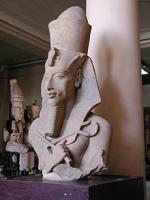Disable ads!
Akhenaton
Nomen Amenhotep Netjer-Heqa-Waset(Year 1-4) Akhenaten (after Year 4 of his reign) Living spirit of the Aten Horus name Kanakht-qai-Shuti(Year 1-4) Kanakht-Meryaten (after Year 4) The strong bull, beloved of the Aten Nebty name Wer-nesut-em-Ipet-swt(Year 1-4) Wer-nesut-em-Akhetaten (after Year 4) Great of kingship in Akhetaten Golden Horus Wetjes-khau-em-Iunu-Shemay(Year 1-4) Wetjes-ren-en-Aten (after Year 4) Who upholds the name of the Aten Consort Nefertiti Kiya Meritaten Ankhesenamun An unidentified sister Children Smenkhkare Meritaten Meketaten Ankhesenamun Neferneferuaten Tasherit Neferneferure Setepenre Tutankhamun Ankhesenpaaten-ta-sherit Father Amenhotep III Mother Tiye Died 1336 or 1334 BC Burial Royal Tomb of Akhenaten, Amarna (original tomb) KV55 (disputed) Monuments Akhetaten, Gempaaten, Hwt-Benben Akhenaten (/ˌækəˈnɑːtən/; also spelled Echnaton, Akhenaton, Ikhnaton, and Khuenaten; meaning "Effective for Aten") known before the fifth year of his reign as Amenhotep IV (sometimes given its Greek form, Amenophis IV, and meaning Amun is Satisfied), was a pharaoh of the Eighteenth dynasty of Egypt who ruled for 17 years and died perhaps in 1336 BC or 1334 BC. He is especially noted for abandoning traditional Egyptian polytheism and introducing worship centered on the Aten, which is sometimes described as monotheistic or henotheistic. An early inscription likens the Aten to the sun as compared to stars, and later official language avoids calling the Aten a god, giving the solar deity a status above mere gods. Akhenaten tried to bring about a departure from traditional religion, yet in the end it would not be accepted. After his death, traditional religious practice was gradually restored, and when some dozen years later rulers without clear rights of succession from the Eighteenth Dynasty founded a new dynasty, they discredited Akhenaten and his immediate successors, referring to Akhenaten himself as "the enemy" or "that criminal" in archival records. He was all but lost from history until the discovery, in the 19th century, of Amarna, the site of Akhetaten, the city he built for the Aten. Early excavations at Amarna by Flinders Petrie sparked interest in the enigmatic pharaoh, whose tomb was unearthed in 1907 in a dig led by Edward R. Ayrton. Interest in Akhenaten increased with the discovery in the Valley of the Kings, at Luxor, of the tomb of King Tutankhamun, who has been proved to be Akhenaten's son according to DNA testing in 2010. A mummy found in KV55 in 1907 has been identified as that of Akhenaten. This man and Tutankhamun are related without question, but the identification of the KV55 mummy as Akhenaten has been questioned. Modern interest in Akhenaten and his queen, Nefertiti, comes partly from his connection with Tutankhamun, partly from the unique style and high quality of the pictorial arts he patronized, and partly from ongoing interest in the religion he attempted to establish.
 Read more on wikipedia.org Read more on wikipedia.org
 All quotes by Akhenaton All quotes by Akhenaton
 Edit Edit
|

|
|
|
|
|
Background photo by Giuliana
|